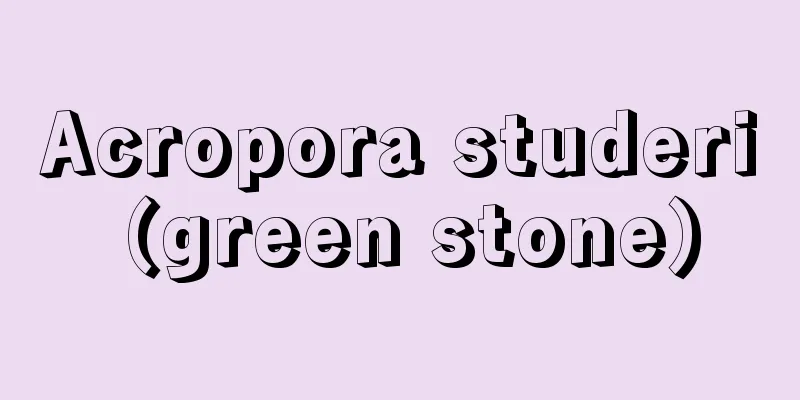Distillation

|
Generally, it is a process in which a solution (mixed solution) is heated, some of it evaporates, and the resulting vapor is transferred to another place and condensed. Strictly speaking, this is called simple distillation. Previously, the character "distillation" was used, but now "remaining" has the opposite meaning. [Yamazaki Akira] historyWhen a mixed solution is distilled, it is usually separated into two or more liquids with different compositions. It has been used since ancient times to concentrate the alcohol content of fermented alcohol. Its origins are said to date back to ancient Greece. The ceramic distillation vessels of that time were called ambix, and eventually spread to the Islamic cultural sphere, and later re-imported to European countries via Spain. The English word alembic indicates this history. It was also imported to Japan during the Edo period, and elaborate designs were made in Japan and called "ranbiki." Wealthy merchants at the time considered it the best form of hospitality to serve their guests alcohol that they had distilled themselves from a ranbiki in front of them, so various elegant luxury products were made. Distillation has been used since ancient times as a means of separation and purification, and is now one of the most important techniques in the chemical industry. Distillation equipment requires at least three parts: a pot, a condenser, and a receiver. The pot is where the raw liquid is placed and heated, the condenser is where the heat is removed from the generated steam to liquefy it, and the receiver is where the condensed liquid is stored. [Yamazaki Akira] Basic Principles of DistillationFor example, consider a two-component system in which a mixed solution consists of a low-boiling component A and a high-boiling component B. When the mixed solution is placed in a flask and heated, and the vapor that comes out is condensed in a condenser, the resulting component will usually have a lower boiling point (and therefore a more volatile liquid) than the original mixed solution. The liquid remaining in the flask will then contain more high-boiling, less volatile components. In this way, by taking advantage of the difference in volatility between A and B and combining evaporation and condensation, the mixed solution can be separated into a volatile part and a less volatile part. The liquid obtained by condensation is called the distillate, and the part that remains unevaporated is called the bottoms. [Yamazaki Akira] DiminutionWhen a vapor mixture is partially condensed, the composition of the resulting liquid phase and the remaining vapor phase are usually not equal. The liquid phase contains more high-boiling components than the original vapor mixture, and the vapor phase contains more low-boiling components. This process of partially condensing to increase the relative concentration of low-boiling components is called partial condensation. Distillation in which the liquid phase produced by partial condensation is brought into contact with new vapor again is called "rectification." [Yamazaki Akira] Various distillation methodsThere are many other distillation methods besides "simple distillation" which can be done with a simple combination of equipment as mentioned above. There are many methods called "distillation" such as "fractional distillation", "reduced pressure distillation", "steam distillation", "decomposition distillation", "extractive distillation", "equilibrium distillation", "azeotropic distillation", "precision distillation", "non-boiling distillation", and "molecular distillation". The first seven of these are described in detail in their respective places, so we will only give a brief introduction here. [Yamazaki Akira] Fractional distillationThis method involves heating a mixture of multiple components and separating and extracting the components by changing the receiver according to their boiling points. If an ideal rectification column could be used, it would be possible to extract each component in its pure form. [Yamazaki Akira] Vacuum distillationAlthough it is often called "vacuum distillation," it is a distillation carried out at a pressure of only a few torr to a few tens of torr (1 torr is approximately the pressure of 1 millimeter of mercury), so "reduced pressure distillation" would be more appropriate. This method is often carried out in laboratories using a water pump, but is not often used industrially because the equipment required is large-scale. [Yamazaki Akira] Steam distillationThe vapor pressure in equilibrium with a mixture of a component that is completely immiscible with water and water is the sum of the vapor pressures of both pure components. When this sum becomes equal to atmospheric pressure, boiling occurs. For example, if heated steam is blown into a mixture of water and turpentine, the mixture of the two components will vaporize under the above conditions, and then be condensed and separated. Even substances that have a high boiling point and decompose when heated can be refined at relatively low temperatures. [Yamazaki Akira] Destructive distillationThe products of petroleum cracking are themselves very hot, so they are immediately introduced into a fractionator for distillation. This process is called decomposition distillation. The equipment, consisting of a cracker and a fractionator, is called a decomposition distillation unit. [Yamazaki Akira] Extractive distillationA method of distillation used for mixtures of components with close boiling points. Unlike azeotropic distillation, which is described later, a third component with low volatility is added to significantly reduce the vapor pressure of one of the components, making separation possible. [Yamazaki Akira] Equilibrium DistillationIt is more commonly known as flash distillation. This is a method for rapidly separating a solution into vapor and liquid, without necessarily aiming to separate the components. When a portion of the liquid heated to a high temperature is taken together with the vapor and the pressure is reduced, the solution rapidly evaporates while maintaining equilibrium with its own vapor. In addition to pipe stills in the oil industry, this method is also used in desalination of seawater and treatment of waste liquids. [Yamazaki Akira] Azeotropic DistillationIn order to separate a mixture that is difficult to separate by normal distillation, a third component is added to form an azeotropic mixture, which is then separated by distillation. A good example is adding benzene to 96% ethanol and distilling it to remove water. Compare this to extractive distillation. [Yamazaki Akira] Precision distillationThis is a method of separating components in a mixture using a multi-stage rectification column, taking advantage of slight differences in boiling points. [Yamazaki Akira] Non-boiling distillationDistillation is carried out for the purpose of purification, but from the viewpoint of efficiency, it is usually carried out under conditions that boil the contents of the vessel to generate a large amount of steam. However, in order to prevent the inclusion of impurities, there are cases where the efficiency does not need to be so high. If a substance has a fairly high vapor pressure even below its boiling point, the degree of purification can be improved by condensing the vapor. This is called non-boiling distillation or sub-boiling distillation. When considering producing distilled water using a distillation apparatus (boiling type) that heats water to its normal boiling point, it is not possible to obtain water of a certain level of purity due to three reasons: (1) creeping of raw water due to wetting of the inner surface of the vessel, (2) contamination of raw water with the effluent due to mist generated during distillation, and (3) increase in the concentration of impurities in the residual liquid. In particular, (2) mist contamination is a major source of contamination. This mist is generated when gas (steam) is generated from inside the liquid phase due to boiling, and the liquid is dispersed. Therefore, by using infrared heating or other methods to slowly evaporate from the surface without boiling, and then condensing this steam, contamination by mist can be eliminated, and a distillate of high purity can be obtained. This method is often used to prepare water and reagents for use in highly sensitive analytical methods such as atomic absorption spectroscopy. [Yamazaki Akira] Molecular DistillationThis distillation method was devised so that it can be used for substances with high boiling points that cannot be distilled by ordinary vacuum distillation. Heating is performed at a pressure of 10 to 100 microtorr. If the distance between the liquid surface and the cooling surface is made smaller than the mean free path of the molecules (the average distance they can fly between successive collisions), most of the molecules that escape from the liquid surface will be returned to the cooling surface, causing liquefaction and condensation. Since the mean free path is a function of molecular weight and pressure, it is possible to separate the liquid from other components by adjusting the pressure and distance. It was once applied to isotope separation, but is now also used for distillation and purification of polymeric substances that are difficult to vaporize, and for distillation of fat-soluble vitamins that decompose easily at high temperatures. [Yamazaki Akira] "Advances in Chemical Engineering 17: Distillation Technology" edited by the Society of Chemical Engineers (1983, Maki Shoten) [References] | | | | | | | | |©Shogakukan "> Basic Principles of Distillation ©Shogakukan "> Structure of the non-boiling distillation pure water production machine Source: Shogakukan Encyclopedia Nipponica About Encyclopedia Nipponica Information | Legend |
|
一般にある溶液(混合溶液)を加熱し、その一部を揮発させ、発生した蒸気を別の場所に移して凝縮させる操作をいう。正確にはこれだけでは単蒸留という。以前は「蒸溜」という字を用いたが、「留」では逆の意味になってしまった。 [山崎 昶] 歴史混合溶液を蒸留すると、通常は組成の異なる2種以上の液体に分けることができる。古くより発酵酒からアルコール分を濃縮するのに用いられてきた。この起源は古代ギリシア時代にまでさかのぼりうるという。当時の陶製の蒸留容器はアムビックスambixとよばれたが、やがてイスラム文化圏に伝わり、のち、スペインを経てヨーロッパ各国に再輸入された。英語のアランビックalembicはこのような歴史を示している。日本にも江戸時代に輸入され、国内でも意匠を凝らしたものができて「蘭曳(らんびき)」とよばれた。当時の豪商は、客の面前で自ら蘭曳から蒸留した酒を客に供するのを最高のもてなしとしたので、いろいろと風雅な高級品がつくられた。このように蒸留は古くから用いられた分離・精製の手段で、現在では化学工業において、きわめて重要な手法の一つとなっている。 蒸留の装置には、少なくとも罐(かま)、凝縮器、受器の3部分が必要である。罐は原料液を入れて加熱するところ、凝縮器は発生した蒸気から熱を奪って液化を行うところ、受器は凝縮した液体をためるところである。 [山崎 昶] 蒸留の基本原理たとえば、混合溶液が低沸点成分Aと高沸点成分Bとからなる二成分系を考えてみよう。混合溶液をフラスコに入れて加熱し、出てくる蒸気を凝縮器で凝縮させると、その成分は、初めの混合溶液よりも低沸点(したがって揮発性に富んだ液)であるのが普通である。そして、フラスコ内に残った液は高沸点の揮発しにくい成分が多くなっている。このようにA、Bの揮発度の差を利用して、蒸発・凝縮を組み合わせて、混合溶液を揮発しやすい部分と、揮発しにくい部分とに分けることができる。凝縮して得られた液体を留分(溜分)、蒸発せずに残ったほうを罐残(かまざん)という。 [山崎 昶] 分縮混合蒸気が一部分凝縮をおこすと、生じた液相と残存の気相の組成は通常は等しくない。液相はもとの混合蒸気よりも高沸点成分が、気相は低沸点成分が多くなる。このように一部分を凝縮させて、低沸点成分の相対濃度を増加させる操作のことを分縮という。分縮で生じた液相がふたたび新しい蒸気と接触するようにして行う蒸留を「精留」という。 [山崎 昶] いろいろな蒸留法前述のような簡単な装置の組合せでできる「単蒸留」のほかにもいろいろな蒸留法がある。「分別蒸留」「減圧蒸留」「水蒸気蒸留」「分解蒸留」「抽出蒸留」「平衡蒸留」「共沸蒸留」「精密蒸留」「非沸騰蒸留」「分子蒸留」などと~蒸留の名でよばれるものは数多い。このうち初めの7項目については、それぞれのところに詳しい記載があるから、ここでは簡略な紹介にとどめることにする。 [山崎 昶] 分別蒸留多成分の混合物を加熱し、沸点ごとに受器をかえて成分を分別して採取する方法。理想的な精留塔が使えれば、各成分を純粋に採取できるはずである。 [山崎 昶] 減圧蒸留よく「真空蒸留」などといわれるが、せいぜい数トルから数十トル(1トルはほぼ水銀柱1ミリメートルの圧力)ぐらいで行う蒸留なので、やはり「減圧蒸留」のほうがふさわしい。水流ポンプなどを利用して実験室ではよく行われる方法であるが、工業的には装置が大規模となることもあってあまり用いられない。 [山崎 昶] 水蒸気蒸留水とまったく混合しない成分と水との混合系と平衡にある蒸気圧は、両方の純成分の蒸気圧の和となる。この和が大気圧と等しくなれば沸騰がおこる。たとえば水とテレビン油の混合物に加熱水蒸気を吹き込むと、前記の条件によって両成分の混合物が気化するから、凝縮させて分離を行う。沸点が高くて加熱すると分解するものでも、比較的低温で精製できる。 [山崎 昶] 分解蒸留石油のクラッキングの生成物はそれ自体がかなり高温であるから、ただちに精留塔に導いて蒸留操作を行う。その操作をまとめて分解蒸留という。装置もクラッキング装置と精留塔とをまとめて分解蒸留装置という。 [山崎 昶] 抽出蒸留沸点の接近した成分の混合物に用いられる蒸留法。後述の共沸蒸留とは違って、揮発性の小さい第三の成分を添加し、一方の蒸気圧を大きく下げて分離を可能とさせる。 [山崎 昶] 平衡蒸留フラッシュ蒸留といわれるほうが多い。これは成分の分離をかならずしも目的とせず、溶液を蒸気と液体に急速に分離する方法である。高温に加熱した液体の一部を蒸気とともに採取し減圧すると、溶液は自身の蒸気と平衡を保ちつつ急速に蒸発する。石油工業でのパイプスチルのほか、海水の脱塩や廃液の処理などにも用いられている。 [山崎 昶] 共沸蒸留通常の蒸留では分離が困難な混合物を分離するのに、第三の成分を添加して共沸混合物をつくらせ、蒸留によって分離を行う方法。96%エタノールにベンゼンを加えて蒸留脱水を行うなどが好例である。抽出蒸留と比較されたい。 [山崎 昶] 精密蒸留多段の精留塔を用い、わずかな沸点の差を利用して混合物中の成分を分離する方法をいう。 [山崎 昶] 非沸騰蒸留蒸留は精製を目的として行われるが、蒸留の効率から考えると、罐の内容物を沸騰させて蒸気を大量に生成するような条件で行うのが通常である。だが、不純物の混入を押さえるためには、効率はさほど高くなくともよい場合もある。沸点以下でもかなり高い蒸気圧をもつ物質であれば、蒸気を凝縮させることによって、精製度を向上させることができる。これを非沸騰蒸留あるいは亜沸点蒸留とよぶ。 通常の沸点まで加熱するタイプの蒸留装置(沸騰型)で蒸留水をつくることを考えると、(1)容器の内面のぬれによる原水の這(は)い上がり(クリーピング)、(2)蒸留時のミスト生成による原水の流出液への混入、(3)残液の不純物濃度の上昇、の3原因のために、蒸留によっても、ある程度以上のきれいな水を得ることはできない。とくに(2)のミストの混入は重要な汚染源である。このミストの生成は、沸騰によって液相の内部から気体(蒸気)が発生するときに、液体の飛散が伴うことが原因である。そこで赤外線加熱などにより、沸騰させぬように表面から緩やかに蒸発をおこさせ、この蒸気を凝縮させると、ミストによる汚染が除かれるから純度の高い留出液が得られる。原子吸光などの高感度の分析法に用いる水や試薬の調製によく用いられる手法である。 [山崎 昶] 分子蒸留普通の減圧蒸留法では蒸留できない高沸点のものにも応用できるように考案された蒸留法。圧力を10~100マイクロトルとして加熱する。液面と冷却面との間隔を分子の平均自由行程(相次ぐ衝突間に飛翔(ひしょう)しうる距離の平均)よりも小さくすると、液面から逸散した分子はほとんど冷却面に補修され、液化、凝縮がおこる。平均自由行程は分子量と圧力の関数であるので、圧力と間隔を調整することによって他の成分との分離が可能となる。その昔は同位体分離に応用されたこともあるが、なかなか気化しにくい高分子物質の蒸留精製や、高温では分解しやすい脂溶性ビタミン類の蒸留などに用いられている。 [山崎 昶] 『化学工学協会編『化学工学の進歩17 蒸留技術』(1983・槇書店)』 [参照項目] | | | | | | | | |©Shogakukan"> 蒸留の基本原理 ©Shogakukan"> 非沸騰蒸留方式純水製造機の構造 出典 小学館 日本大百科全書(ニッポニカ)日本大百科全書(ニッポニカ)について 情報 | 凡例 |
<<: Distilled liquor - Jouryuushu
Recommend
Silvester II
…French clergyman and educator, skilled in mathem...
Kanegamisaki - Kanegamisaki
(1) The title of a jiuta piece. Nakamura Tomijuro ...
Nobumasa Okudaira
Year of death: Genna 1.3.14 (1615.4.11) Year of bi...
Economic law
It is a general term for laws that aim for the st...
Marinatos, S.
...This pumice and volcanic ash are dacite, and w...
flame analysis
...When a substance is placed in a flame, the ato...
Interference
In wireless communication, interference occurs whe...
Anti-skid brakes
…Traditionally, electromagnetic brakes have been ...
Petition - petition
It refers to the act of citizens directly express...
Kisai [town] - Kisai
An old town in Kitasaitama District, northeastern ...
Matos Rodríguez, GH (English spelling)
...The most widely known tango song. It is said t...
Omphacite - Omphacite
A mineral belonging to the alkali pyroxenes. Its c...
Edo Sodachi Festival Sashichi
A Kabuki play. A domestic drama. Three acts. Writ...
Bipalium - Bipalium (English spelling)
A general term for animals in the phylum Platyhel...
Clethrionomys rufocanus bedfordiae (English name) Clethrionomysrufocanusbedfordiae
…[Tadaaki Imaizumi] [Yoshinori Imaizumi]. … *Some...









